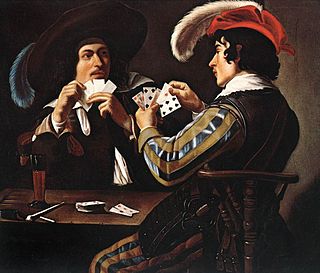
A card game is any game using playing cards as the primary device with which the game is played, be they traditional or game-specific. Countless card games exist, including families of related games. A small number of card games played with traditional decks have formally standardized rules with international tournaments being held, but most are folk games whose rules may vary by region, culture, location or from circle to circle.

Upwords is a board game. It was originally manufactured and marketed by the Milton Bradley Company, then a division of Hasbro. It has been marketed under its own name and also as Scrabble Upwords in the United States and Canada, and Topwords, Crucimaster, Betutorony, Palabras Arriba and Stapelwoord in other countries. It is currently available as a board game and a digital gaming app.
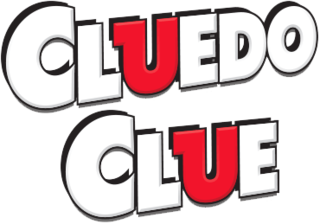
Cluedo, known as Clue in North America, is a murder mystery game for three to six players that was devised in 1943 by British board game designer Anthony E. Pratt. The game was first manufactured by Waddingtons in the United Kingdom in 1949. Since then, it has been relaunched and updated several times, and it is currently owned and published by the American game and toy company Hasbro.
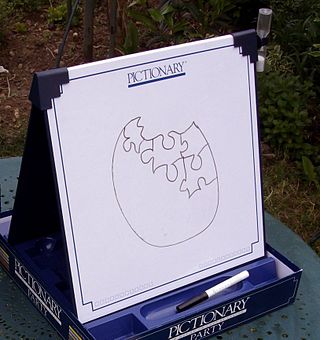
Pictionary is a charades-inspired word-guessing game invented by Robert Angel with graphic design by Gary Everson and first published in 1985 by Angel Games Inc. Angel Games licensed Pictionary to Western Publishing. Hasbro purchased the rights in 1994 after acquiring the games business of Western Publishing. Mattel acquired ownership of Pictionary in 2001. The game is played in teams with players trying to identify specific words from their teammates.

Boggle is a word game in which players try to find as many words as they can from a grid of lettered dice, within a set time limit. It was invented by Allan Turoff and originally distributed by Parker Brothers.
Spite and Malice, also known as Cat and Mouse, is a relatively modern American card game for two or more players. It is a reworking of the late 19th century Continental game Crapette, also known as Russian Bank, and is a form of competitive solitaire, with a number of variations that can be played with two or three regular decks of cards.
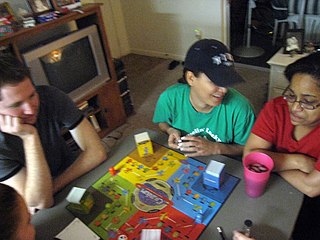
Cranium is a party game created by Whit Alexander and Richard Tait in 1998. Initially, Cranium was sold through Amazon.com and the Starbucks coffee chain, then-novel methods of distribution. After selling 44 million copies of Cranium and its sister titles, the game's manufacturer Cranium, Inc. was bought by Hasbro, Inc. for $77.5 million in 2008. Billed as "The Game for Your Whole Brain", Cranium includes a wide variety of activities, unlike many other party games. Giorgio Davanzo handles packaging and branding for the game, and the artwork is by cartoonist Gary Baseman.
Rubber bridge is a form of contract bridge played by two competing pairs using a particular method of scoring. A rubber is completed when one pair becomes first to win two games, each game presenting a score of 100 or more contract points; a new game ensues until one pair has won two games to conclude the rubber. Owing to the availability of various additional bonus and penalty points in the scoring, it is possible, though less common, to win the rubber by amassing more total points despite losing two games out of three. Rubber bridge involves a high degree of skill but there is also a fair amount of luck involved in who gets the best cards. A popular variation of rubber bridge is known as Chicago.

Quiddler is a card game and word game created by Set Enterprises. Players compete by spelling English words from cards in hands of increasing size, each card worth various points. The game combines aspects of Scrabble and gin rummy. The word "Quiddler" is a trademark.

Catch Phrase is a word guessing party game commercially available from Hasbro.
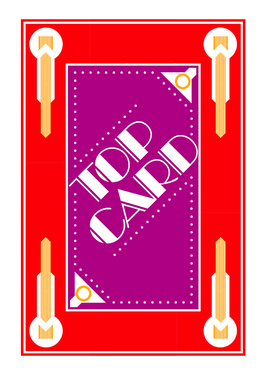
Top Card is a game show that aired on TNN and produced by Reid-Land Productions, replacing TNN's original game show Fandango. The show aired from April 3, 1989 to March 26, 1993 and was based on the card game Blackjack.
Scattergories is an American game show on NBC daytime hosted by Dick Clark, with Charlie Tuna as announcer, that aired from January 18 to June 11, 1993. The show, which was adapted from the Milton Bradley board game of the same name, was produced by Reg Grundy Productions and was the second to last American game show to be produced by the company.
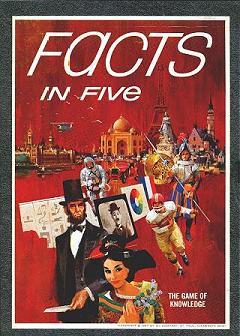
Facts in Five: The Game of Knowledge is a trivia game for two or more players, designed in 1964 by Rick Onanian.
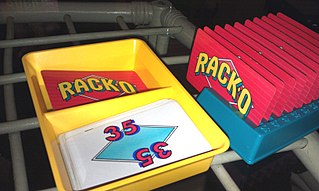
Rack-O is a Milton Bradley sequential-matching card game with the objective of obtaining 10 numbers, in numerical order, in one's hand. Score may be kept on a separate piece of paper, based upon either a custom system or the system provided in the rule book. Rack-O allows between 2–4 players, and is recommended for players age 8 and up. Rack-O was released in 1956 and is currently produced by Winning Moves Games USA.

Probe is a parlor game or board game introduced in the 1960s by Parker Brothers. It is reminiscent of the simple two-person game Hangman, whose object is to guess a word chosen by another player by revealing specific letters. Probe extends the number of players to a maximum of four and introduces additional game elements that increase the levels of both skill and chance. Like Hangman, each player has a secret chosen word. But unlike Hangman, the game ends when the last word, not the first word, is revealed. All players remain in the game until the end. It was created by Ted Leavitt and licensed by him to Parker Brothers.
The Figure It Out board game was based on the popular children's game show Figure It Out on Nickelodeon. It was produced by Cardinal Games in 1998 and included a Billy the Answer Head board that was coated to allow for writing and erasing with crayon, two sets of game cards, and a timer.
A number of related games under the Yahtzee brand have been produced. They all commonly use dice as the primary tool for game play, but all differ generally. As Yahtzee itself has been sold since 1954, the variants released over the years are more recent in comparison, with the oldest one, Triple Yahtzee, developed in 1972, eighteen years after the introduction of the parent game.
Family Game Night is an American television game show based on Hasbro's family of board games and EA's video game franchise of the same name. The show was hosted by Todd Newton. Burton Richardson was the announcer for the first two seasons; he was replaced by Stacey J. Aswad in the third season, and Andrew Kishino was hired for the fourth season. The 60-minute program debuted on October 10, 2010, on The Hub ; it was previewed on October 9, 2010, on its sister channel, TLC. Seasons 1 and 2 contained 26 and 30 episodes respectively. Seasons 3, 4 and 5 each contained 15 episodes. Season 2 premiered on Friday, September 2, 2011, with additional games being added. The games added to the second season included Cranium Brain Breaks, Green Scream, Ratuki Go-Round, Simon Flash, Operation Sam Dunk, Trouble Pop Quiz, and Spelling Bee. However games from the previous season were still kept.

Lexicon is a word game using a dedicated deck of cards for 2 to 4 players published as a shedding card game.
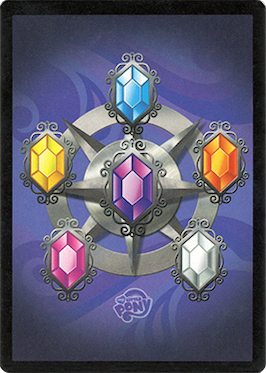
The My Little Pony Collectible Card Game is a two-player collectible card game based on the animated television series My Little Pony: Friendship Is Magic. It is produced by Enterplay LLC under license from Hasbro, and follows from Enterplay's previous work to produce a trading card series based on the same show.

















